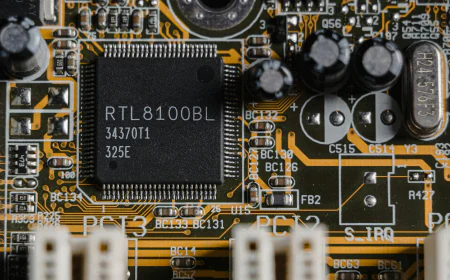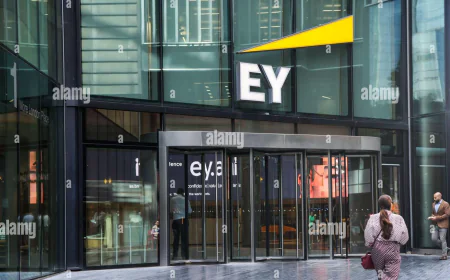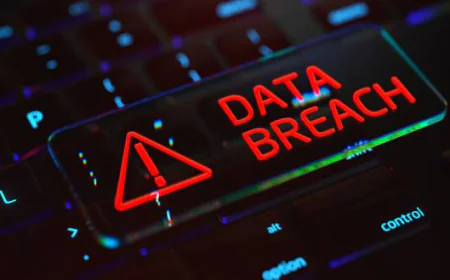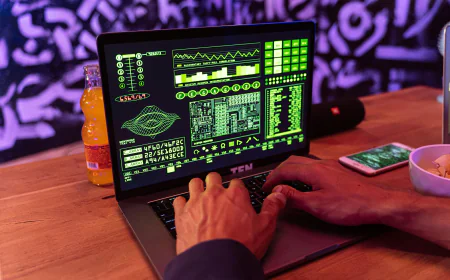A New Security Layer for macOS Takes Aim at Admin Errors Before Hackers Do
ThreatLocker has presented its Defense Against Configurations (DAC) technology for macOS to provide a solution for substantial security issues that are mainly attributed to improper configuration. This groundbreaking software not only monitors Macs several times a day but also detects and corrects risky settings such as non-encrypted drives, firewalls turned off, and outdated protocol usage, granting companies using Apple gadgets a complete and automated compliance for risk control and monitoring. DAC security posture is improved by transforming configuration management into a preventive, control aligned with standards.

The Silent Vulnerability Hidden in Your Mac: Why Configuration Errors Have Become the Hacker News of 2025
The cybersecurity news cycle is a fast-moving one, and amidst this it a new narrative regarding threat is coming up which does not involve zero-day attacks or malware but is a lot more basic and still very effective: configuration errors. To support the latest hacker news reports, misconfigurations are already the most favored entry point for modern cyberattacks and now, ThreatLocker is coming up with its revolutionary Defense Against Configurations (DAC) technology for macOS to tackle the issue head-on.
Let's assume a situation that is happening many times during the day in creative industries all over the world. The creative director of a design agency is sitting in front of a MacBook Pro and working on a high-stakes campaign video. A collaborative app is asking for permission to use the microphone and the camera—this is a common request in today's connected work environment. macOS is to detect the unusual permission requests using strict security measures, but in this case, the security measures are not so strict. Therefore, the app is able to get the access. At the same time, in another part of the office, files are being shared through SMB version one—an obsolete protocol that, while easy and fast, makes the system extremely vulnerable. Cybersecurity professionals know that should an intruder get access through the internet, it would take less than a minute for him to exploit this outdated protocol.
Such scenarios depict the cybersecurity news scenario of late 2025 with configuration vulnerabilities being the main theme for modern cybercriminals. However, these are not breaking of the superior hardware or advanced antivirus software but rather configuration errors that create invisible vulnerabilities that remain undetected because no one is actually looking for them.
Understanding the Configuration Crisis in Modern Cybersecurity

For a long time, the cybersecurity community has been aware that security is a multi-layered process, however, the configuration layer has been neglected. Misconfigurations in hacker news and cyber security news are referred to as "gifts to attackers" by security professionals. The gifts are varied, for example, default settings that have been left permanently turned on, remote access protocols that should be shut down but are still alive, unpatched network protocols like SMB v1 still running, or encryption that wasn't switched on although this was specified in the organizational security policies.
The recent cybersecurity news coverage has pointed out that these configuration errors are found in organizations that even take security very seriously. They are not due to carelessness or lack of skill. Instead, they arise from the difficulties involved in using modern operating systems, pressure to keep productivity at the same level, and the sheer challenge of keeping track of hundreds of configuration variables on enterprise networks. In the battle for authority and visibility in hacker news reporting, configuration vulnerabilities have achieved a status of great importance because they lead to systems that attackers can easily access.
In this context, ThreatLocker's innovative approach stands out in cyber security news. The company is aware that configuration management is the missing link in the current cybersecurity scenario.
Defense Against Configurations: A Game-Changer in Endpoint Security News

After the Defense Against Configurations platform for Windows no less than August 2025’ success that launch of ThreatLocker—cybersecurity news fast and thus became the focal point the platform has made its way to Mac now. Presently with beta version, DAC for Mac is a game-changer in hacker news, especially for those companies or organizations that have totally dependent on Apple’s ecosystem for their tech infrastructure.
The operation of the technology is amazingly simple. The ThreatLocker agent does a complete configuration scan to a maximum of four times each day and among others, the risky or noncompliant settings are shown within the well-known ThreatLocker dashboard. For organizations that are already using ThreatLocker to manage their Windows endpoints, the macOS support has brought about unified visibility, which has indeed attracted a lot of attention among the circles of endpoint security news.
It is of great importance this unified approach that it has gotten rid of the fragmentation which has been a major issue for a long time in multi-platform organizations. IT managers do not have to use different tools, have separate dashboards or separate procedures for their Mac and Windows fleets anymore. The cybersecurity news media have pointed out that this integration is a major milestone in the field of effective cyber security administration.
High-Value Controls: What DAC Monitors on macOS
The beta version of DAC for the macOS operating system looks at what ThreatLocker describes as “high-value controls” - the configuration elements that pose a risk to the organization if not properly configured. This prioritization is based on knowledge gained from case studies and breach investigations in the field of cybersecurity over the last few years.
Disk encryption status (FileVault): The device keeps track of which and how many drives are encrypted with the shutdown. The data breaches that have been reported in the hacker news always mention unencrypted drives as critical vulnerability factors. No encryption means a stole or lost MacBook is an open book for the attackers.
Built-in firewall status: The verification status is in the category of the macOS firewall. The macOS firewall provides the most excellent protection if it is turned on and operating without any hitches. However, numerous security audits conducted in the cyber world have in the past revealed this basic protection disabled or incorrectly set up in most corporations.
Sharing and remote access settings: That is the category that is proved to be the most important. Vulnerabilities such as remote login can be used by attackers if they get access to your network. Remote access misconfigurations have been consistently reported in the recent cyber news as the entry point for the among the hackers’ attacks on the most publicized businesses.
Local administrator accounts: Companies often leave inactive administrator accounts—configuration mistakes that hacker news has often pointed out—alive giving attackers the chance to get through. DAC informs the company of every administrator privileged account and alerts about potentially suspicious setups.
Automatic update settings: In the cyber security world, the non-performing and late automatic updates have attained a point where they are consistently considered among the most dangerous misconfigurations. The DAC system is there to make sure that needed patches are installed timely.
Gatekeeper and app source controls: These great security features of Apple decide which software can be run on a system.
Why macOS Security Now Demands This Level of Attention
The creative industries—design studios, media production companies, video editing facilities, music production houses, and software development teams—have always been keen on macOS. The reasons for that are well explained in the industry publications and discussions on hacker news: Apple's M-series processors give outstanding performance for graphical works, being very quiet and consuming very little power at the same time. This hardware benefit made a situation where creative workers took Mac equipment as the standard.
On the other hand, as cybersecurity news has been exposing, the security visibility has not become equal to the hardware adoption. Windows environments have had their security posture well supported with extensive development but macOS security tools have not been so lucky. The "macOS is software with no getting-in risks" cliché has drawn a troublesome no man's land in the domains that are the most likely ones to host valuable corporate intellectual property and client data.
DAC for macOS is here to help in this situation. The platform ensures that the design team, studios, and production companies are one step ahead of the hackers through a vulnerability detection process. Systematic review is applied to hacking news-identified configuration factors like unencrypted drives, disabled firewalls, lingering admin accounts, and sharing settings that allowed access.
Configuration Visibility as a Strategic Advantage

The method used by ThreatLocker signifies a movement in cybersecurity opinion that is also mentioned in depth by cyber security news. Modern defenders are changing their standpoint from prevention of known attacks only to getting the right understanding of and having control over their environment. The security effectiveness relies on configuration visibility as the main ingredient.
With DAC detecting a wrong configuration, the process is not just limited to notification. The platform directly links these results to the ThreatLocker policies which can take action. Such a combination makes configuration management a compliance task and at the same time an operational control. As the analysis of hacker news has pointed out, the closed-loop approach—from detection to remediation—is the future of the security industry and its practical applications.
Disallowed actions give security the upper hand to work with the infrastructure while meeting security frameworks and insurance requirements at the same time. This plays a huge role for security teams in charge of complex multi-site deployments. Automated configuration management, which has been pointed out in endpoint security news, is a way to decrease both the human workload and the chances of mistakes occurring.
Real-World Impact: When Configuration Errors Become Costly Breaches
This feature is really important if we look at real incidents that were in the news regarding cybersecurity. The WannaCry ransomware attack, which was heavily publicized and most of the information can still be found in hacker news archives, took it through the SMB path. The organizations that turned off SMBv1 didn't have any infections; on the other hand, those that did not get infections experienced organizational disruption on a massive scale. This one single decision regarding configuration had a huge impact on whether an organization was able to continue operating or was paralyzed by lack of operations.
In similar ways, over and over again, there appear to be consistent patterns in the cyber security news breach investigation. The attackers are not frequently relying on very complex zero-day exploits or advanced persistent threat (APT) capabilities. Instead, their strategy is to try to find in a very methodical way configuration mistakes, systems not patched and/or security controls that are disabled. The feeling of inevitability regarding the breach is often felt by the cybersecurity professionals when they meet these conditions—an open door for the attackers.
However, DAC has a different effect on the situation. It scans up to four times a day and instantly uncovers the configuration problems, which means that the administrators get many chances every day to fix the flaws before the attackers can get in. In hacker-lingo, it changes the defenders from being reactive responders to proactive managers.
Integration With Broader Security Frameworks

One of the very impacting aspects of DAC in the realm of cybersecurity news, in particular, is its integration with the different frameworks. Thus for example, ThreatLocker, instead of providing a new proprietary security framework, aligned its results with the already established standards: CIS, NIST, ISO 27001, and HIPAA. This is a clever move showing great insight into enterprise security operations.
Simultaneously, organizations need to meet the demands of different regulators, comply with the requirements of cyber insurance, and follow their internal security policies. Commonly, these frameworks will overlap each other, but not entirely. DAC's multi-framework mapping enables a single remediation action to satisfy the compliance requirements of the various frameworks at the same time. Such an improvement in the efficiency of the compliance process means huge benefits in the complicated world of modern cybersecurity.
For the people observing the cybersecurity news, the framework-aware approach brings the message of maturity in the configuration management area. Such a situation has been the case, where instead of starting from the ground up, vendors are increasingly coming to realize that the security product has to be integrated with the existing governance in the organization to be successful.
The Path Forward: What This Means for Organizations
The introduction of DAC for macOS has a far-reaching impact that is not only limited to the creative industries, although these sectors are the most immediate ones to benefit from it. The implication of hacker news mentioning this is that configuration management is one of the modern cybersecurity frontiers.
There are several practical advantages for organizations using DAC. To begin with, they have continuous visibility into the configuration state which is not a one-time audit but ongoing monitoring. Secondly, they have documented evidence of security hygiene, which is useful for regulatory compliance and cyber insurance purposes. Thirdly, they have implemented automated pathways for remediation that would otherwise require manual intervention and be prone to human error.
From the perspective of cybersecurity news, these capabilities mean that a significant improvement in security posture could be achieved without the need for going to the extent of considerably increasing the IT staff or budget.
Conclusion: Configuration Visibility as Security's Next Frontier
The arrival of Decentralized Access Control (DAC) for macOS, which has been extensively talked about in the latest cyber security news, is the recognition of a very important fact: the modern attacks rely on the exploiting of the misconfigurations way more than they do on the sophisticated technical vulnerabilities. Hacker news articles and cybersecurity news reports are increasingly converging on this truth.
The solution provided by ThreatLocker accepts this fact and by providing systematic visibility into the configuration state and automated pathways to compliance, it helps organizations in controlling the entire landscape of the hardware and software that they are using. For those who have had difficulty keeping their security posture steady in the midst of varied hardware platforms and complicated situations, DAC is a practical way out that the IT operation realities can relate to.
Configuration management will, according to continuous hacker news and cyber security news mentioning the trends, likely become one more day-to-day operation in security just like antivirus software was in the past. The release of ThreatLocker's DAC for macOS is the very first step towards that point, and it finally opens up the Mac world to the same visibility and control frameworks that the forward-thinking companies have long implemented for Windows.
For IT departments, security experts and organizational leaders keeping an eye on the latest events in the computer security news and endpoint protection news, the DAC for macOS is worth being considered seriously. The tool fills a real gap in the present defenses, not with complexity or additional alert fatigue but with clarity, actionability, and practical remediation pathways.
































